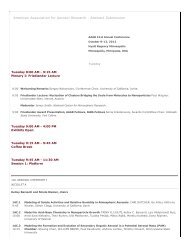Download PDF of Conference Program Book - AAARabstracts
Download PDF of Conference Program Book - AAARabstracts
Download PDF of Conference Program Book - AAARabstracts
- No tags were found...
Create successful ePaper yourself
Turn your PDF publications into a flip-book with our unique Google optimized e-Paper software.
California Air Resources Board, and as an Associate<br />
Editor for Environmental Science & Technology. A member<br />
<strong>of</strong> AAAR since 1986, Dr. Hildemann has served as an<br />
Associate Editor <strong>of</strong> AS&T, as a member on the AAAR’s<br />
Board <strong>of</strong> Directors and Editorial Board, and as Chair <strong>of</strong> the<br />
Awards Committee and the Publications Committee.<br />
Wednesday, October 5<br />
8:00 am – 9:15 am<br />
AeroSol, Cloud, And preCIpITATIon<br />
InTerACTIonS: AnThropoGenIC And<br />
nATurAl effeCTS<br />
Bruce Albrecht, University <strong>of</strong> Miami, Miami, FL<br />
Abstract: The role <strong>of</strong> aerosols in cloud and precipitation<br />
formation and evolution was documented in some <strong>of</strong><br />
the earliest cloud studies based on aircraft observations<br />
made in the 1950s. A key finding <strong>of</strong> these early studies<br />
was that the microphysical characteristics <strong>of</strong> marine<br />
and continental clouds exhibited marked differences<br />
that were attributed to aerosol differences between<br />
the two environments. But the possible importance <strong>of</strong><br />
aerosol-cloud-precipitation interactions in affecting<br />
cloud properties critical to climate was not brought<br />
to the forefront until some 20-30 years later when<br />
mechanisms that that are now called the first and second<br />
aerosol indirect effects were postulated. The first is<br />
a brightening <strong>of</strong> clouds associated with increases in<br />
aerosols that serve as cloud condensation nuclei (CCN)<br />
and will distribute cloud water among smaller droplets<br />
that more effectively reflect solar radiation. The second<br />
is an increase in the cloud lifetime (or cloud amount)<br />
as increased CCN reduces precipitation efficiency and<br />
the removal <strong>of</strong> cloud water. Both effects would lead to<br />
increased cloud albedo with increased aerosols. The first<br />
indirect effect has a strong theoretical basis, since the<br />
relationship between droplet size and cloud reflectivity<br />
can be defined theoretically and the relationship<br />
between CCN concentration and droplet number<br />
(and size) is well established. But the second indirect<br />
effect has a weaker foundation, since the precipitation<br />
mechanisms as they relate to aerosols are not defined<br />
easily in terms <strong>of</strong> basic physical principles. Further,<br />
an additional element <strong>of</strong> the second indirect effect is<br />
that in an environment <strong>of</strong> low CCN and precipitating<br />
www.AAAR.org<br />
plenary lectures<br />
41



